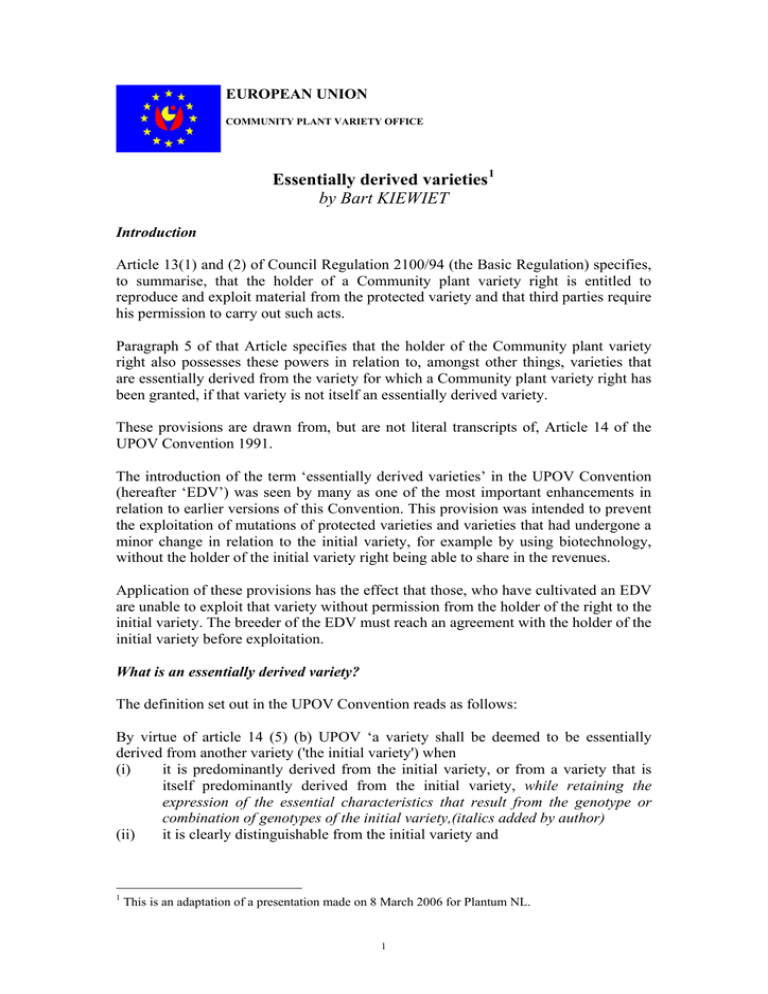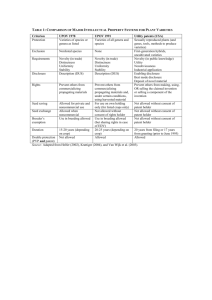Essentially derived varieties
advertisement

EUROPEAN UNION
COMMUNITY PLANT VARIETY OFFICE
Essentially derived varieties 1
by Bart KIEWIET
Introduction
Article 13(1) and (2) of Council Regulation 2100/94 (the Basic Regulation) specifies,
to summarise, that the holder of a Community plant variety right is entitled to
reproduce and exploit material from the protected variety and that third parties require
his permission to carry out such acts.
Paragraph 5 of that Article specifies that the holder of the Community plant variety
right also possesses these powers in relation to, amongst other things, varieties that
are essentially derived from the variety for which a Community plant variety right has
been granted, if that variety is not itself an essentially derived variety.
These provisions are drawn from, but are not literal transcripts of, Article 14 of the
UPOV Convention 1991.
The introduction of the term ‘essentially derived varieties’ in the UPOV Convention
(hereafter ‘EDV’) was seen by many as one of the most important enhancements in
relation to earlier versions of this Convention. This provision was intended to prevent
the exploitation of mutations of protected varieties and varieties that had undergone a
minor change in relation to the initial variety, for example by using biotechnology,
without the holder of the initial variety right being able to share in the revenues.
Application of these provisions has the effect that those, who have cultivated an EDV
are unable to exploit that variety without permission from the holder of the right to the
initial variety. The breeder of the EDV must reach an agreement with the holder of the
initial variety before exploitation.
What is an essentially derived variety?
The definition set out in the UPOV Convention reads as follows:
By virtue of article 14 (5) (b) UPOV ‘a variety shall be deemed to be essentially
derived from another variety ('the initial variety') when
(i)
it is predominantly derived from the initial variety, or from a variety that is
itself predominantly derived from the initial variety, while retaining the
expression of the essential characteristics that result from the genotype or
combination of genotypes of the initial variety,(italics added by author)
(ii)
it is clearly distinguishable from the initial variety and
1
This is an adaptation of a presentation made on 8 March 2006 for Plantum NL.
1
(iii)
except for the differences which result from the act of derivation, it conforms
to the initial variety in the expression of the essential characteristics that result
from the genotype or combination of genotypes of the initial variety.'
The definition as it appears in the Basic Regulation is drawn in essence from the
UPOV definition, but it is not exactly the same.
A variety is classified as an EDV “when:
(a)
it is predominantly derived from the initial variety, or from a variety that is
itself predominantly derived from the initial variety;
(b)
it is distinct in accordance with the provisions of Article 7 from the initial
variety; and
(c)
except for the differences which result from the act of derivation, it
conforms essentially to the initial variety in the expression of the
characteristics that results from the genotype or combination of genotypes
of the initial variety.”
The first difference between the two definitions is that the phrase, shown in italics
under (i) in the UPOV definition, is not included in the Basic Regulation. The
Regulation text furthermore talks of “conforms essentially … in the expression of the
characteristics” and the UPOV Convention talks of “conforms to … in the expression
of the essential characteristics”. In my opinion, what this amounts to is editorial
intervention to clarify the definition. The Community legislator did assumedly not
intend to introduce a notion of EDV that deviated from the one laid down in the
UPOV Convention.
The characteristics that the derived variety must fulfil are cumulative.
Paragraph (a) means that an EDV can only have a juridical relevant dependency from
one variety, “the initial variety”, which is protected under the Basic Regulation. It
need not be directly derived from the initial variety. The EDV may also be bred by
using one or more other variety (ies) predominantly derived from the initial variety.
Paragraph (b) implies that the derived variety must be an independent variety,
distinguishable from the initial variety. It follows from the wording of Article 7 of the
Basic Regulation (where there is mention of 'the expression of the characteristics that
results from a particular genotype or combination of genotypes') that the distinction
must be able to be established on the basis of phenotypical characteristics. A
distinction at this level may have a very limited genetic basis.
Paragraph (c) provides that the derived variety may only differ from the original
variety in differences resulting from the act of derivation. There is an ongoing debate
over the meaning of this paragraph. Two important questions arise in this context.
The first question is, whether this involves differences or a correlation at the
phenotypical level. I would suggest this question should be answered in the
affirmative. The phrase used is ‘expression of characteristics that result from the
genotype or combination of genotypes’. This makes in my opinion clear that in this
respect only expressed, genetically heritable, characteristics, should be taken into
account. The parallel with Article 7, quoted earlier, is clear.
2
The second question is whether there is a quantitative restriction on the number of
permitted morphological differences. This question is harder to answer. An
interpretation based purely on the text of this paragraph leads to a negative answer;
there is no quantitative restriction but only a qualitative restriction on permitted
differences: these must be differences that result from the act of derivation. It follows
from a judgment by the District Court in The Hague that there is yet another approach
possible based on the legislative history of this provision. In its protocol for perennial
ryegrass, ISF also appears to proceed on the principle that there must be a high degree
of phenotypical correlation between the EDV and the original variety. I shall come
back to the judgement and the ISF protocol later.
Who determines what an EDV is?
While the Basic Regulation does not explicitly say so, it must be understood that it is
the holder of the initial variety who must demonstrate that another variety is derived
from his variety in case of dispute. In an application procedure, there is no role for
authorities charged with granting plant variety rights to determine whether a variety is
an EDV. In this context, one should point out that an EDV need not be protected and
may therefore entirely elude the attention of the authority granting plant variety rights.
A variety may only be registered as an EDV to an initial variety in the register of the
CPVO if the parties agree or if there is a judgment to this effect (Article 87.2.h and 99
Basic Regulation).
If the breeder of an EDV does not deny that status for the variety, he will need the
consent of the holder of the initial variety in order to be able to exploit the variety
commercially.
If the holder of the alleged EDV denies that his variety is an EDV, the holder may ask
a national court for an acknowledgement of the identification of the varieties
concerned as initial and essentially derived (Article 99 Basic Regulation).
How can one establish that a variety is an EDV?
The answer to this ought to lie within the definition of an EDV.
Bearing the definition in mind, there are two principal criteria that have to be met by
an EDV.
I - There must have been an act of derivation. In de Basic Regulation no examples are
given of such acts. The UPOV convention is more complete in that respect. Article 14
(5 c) contains the following provision:
“Essentially derived varieties may be obtained for example by the selection of a
natural or induced mutant, or a somaclonal variant, backcrossing, or transformation by
genetic engineering” This is not an exhaustive enumeration.
II - Apart from the differences arising from the derivation, there must be a significant
extent of similarity at, as argued above, the phenotypical level.
The application of these principles may encounter problems of interpretation in
practice. It is, therefore, a welcome initiative for ISF and CIOPORA to try and agree
on codes of conduct that can be used on a voluntary basis for resolution of an EDV
dispute. The courts would not be bound by any such code, but would be inclined to
lend significant weight to whatever had been agreed on between breeders at an
international level.
3
The approach pursued in one of the protocols adopted by ISF, the one for perennial
ryegrass, is that, if there is any doubt as to whether a new variety is an EDV of
another variety (initial variety) - doubt based on the fact that the new variety ‘presents
the essential characteristics of that initial variety’ - the genetic distance between the
two varieties (the squared Euclidian distance) will have to be measured. If the
distance is 7 or less, then there are grounds for seeking arbitration, where it is possible
that the burden of proof may be reversed; the grower of the alleged derived variety
would have to demonstrate that he did not derive that variety. In such cases, the
breeding history would have to be tabled.
Here, therefore, we see that the trigger point is that two varieties display the same
essential characteristics. Whilst not stated explicitly, logic takes along that we are
talking about phenotypical correlations. The genetic comparison is the next step.
In the ISF Guidelines for 'EDV in Lettuce', there is a description of a method for
genetic comparison of lettuce varieties. Probably also here phenotypical correlations
form the trigger point for this comparison.
While the principles behind this type of code is widely supported, it does not seem to
be easy to reach agreement on acceptable codes for all the parties involved in relation
to the most important species. ISF has adopted only a limited number of codes.
CIOPORA is in the process of developing a document as regards the issue of EDV’s.
The Courts
If the parties cannot agree, then the courts will have to have the final word. There is
little by way of case law available, which might indicate that in most cases the parties
can sort matters out amongst themselves. Another explanation might be that the costs
of a legal action do not balance the ‘profit’ that such an action might provide. The
District Court in The Hague, in a recent case between Astée Flowers and Danziger
'Dan' Flower Farm (13 July 2005) made some findings in principle on the expression
‘essentially derived variety’. Here are a few excerpts:
'a variety, even if it is to be regarded as deriving from another variety, may not differ
significantly from the original variety';
'When this Regulation came into effect, the thinking was apparently that derived
varieties were ones where just one or a few characteristics differed from the original
variety…';
'… the extension of the protection for original varieties to derived varieties (is) to be
considered as an exceptional provision … which must be interpreted restrictively by
its nature.'
'The … differences established … are so major in number and content that we can no
longer justify the conclusion that we are talking of one or a few differences, as
required for an essentially derived variety.'
The court in The Hague would not therefore embark on a genetic comparison if there
were major morphological differences between the varieties in question.
I am aware that this approach is not supported by everyone.
Since an appeal has been lodged, I shall refrain from commenting at this stage.
4
Conclusion
The question of how far an EDV and the original variety have to resemble each other
phenotypically is a difficult one to answer, since the definition offers scope for
various interpretations. Establishing whether a variety is an EDV, based purely and
simply on a genetic comparison, seems in any case not to be in line with the criteria
set out in the definition of an EDV. Case law and protocols used by breeders’
organisations are both of essential importance to a successful translation of the notion
‘EDV’ into practice.
April 2006
Bart Kiewiet
President CPVO
5



